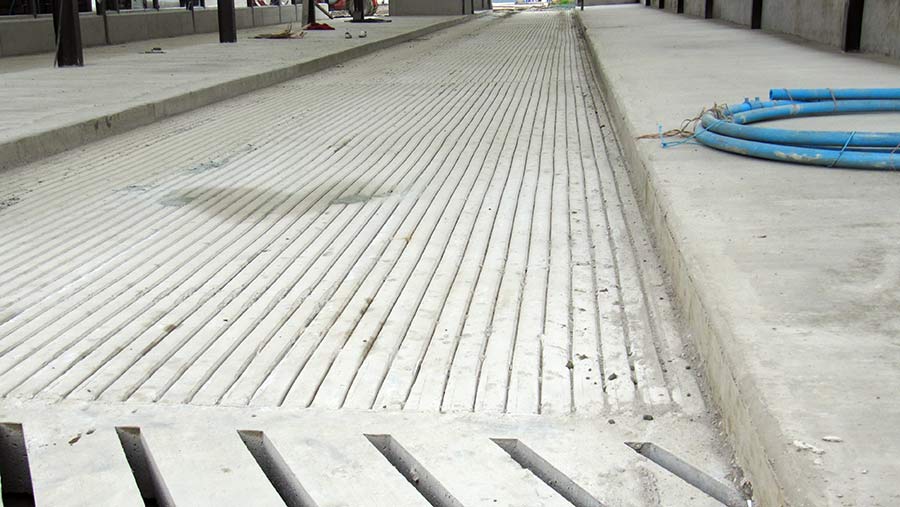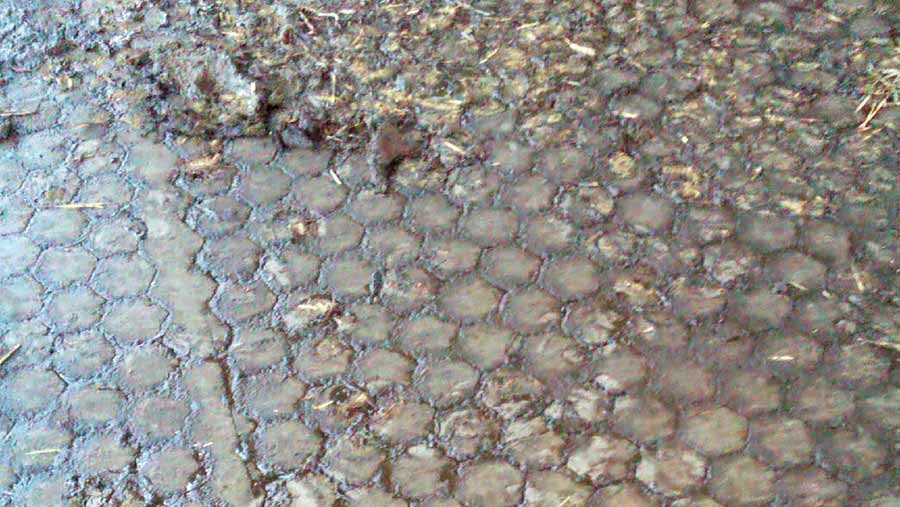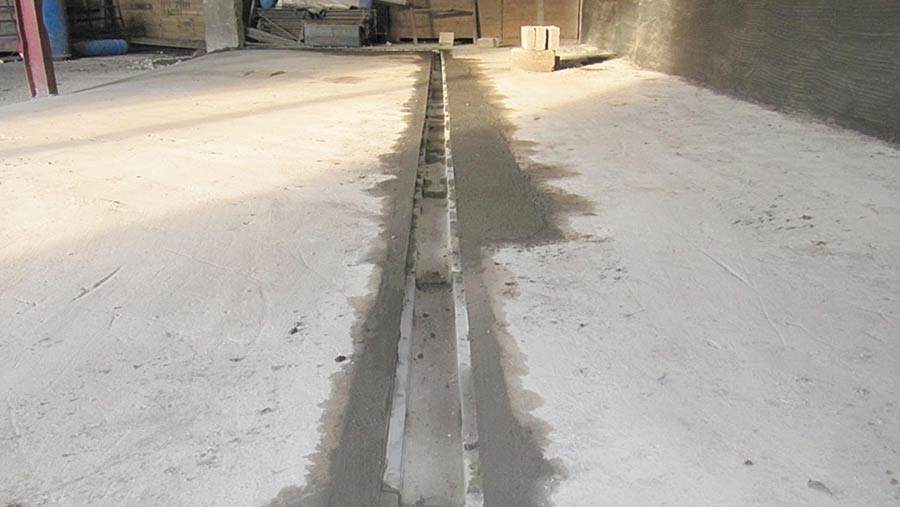Building for better herd health: Good floors
 © Jamie Robertson
© Jamie Robertson Floors are where all of the food, all the feet, all the waste, and all of the bedding goes. It also requires a huge labour input and is also where all the money is made, or lost.
So it is strange to find so many livestock buildings where the design and quality of the floors look to be of secondary value to the building above them.
The value of good design and layout of floors is calculated directly in hours and cash, and indirectly in managing the inevitable consequences of stress and disease.
See also: Building for better herd health: shed walls
The size and layout of pens dictate stocking density, the width of the pen dictates available feed space, and both of these factors influence animal behaviour and growth rates.
Group sizes and therefore pen sizes should ideally fit the requirements of the business, not the other way round.
Floors and feet
AHDB Dairy calculates the average cost per dairy cow with foot damage in the UK dairy herd is around £180, with lameness being a major reason for early culling in both the dairy and the pig breeding sectors. This equates to £15,000 a year for an average UK dairy herd.
Prevention is better than cure, and while there is understandable focus on treatment of the pathogens associated with lameness, there is frequently a significant environmental component to the problem.
Pooling on cubicle house creates a hotspot of dirty water, which is a biological soup, where all the cows can share all the bugs.
Advice for floors
Attention to detail during the construction or improvement to floors is always a good investment because the impact will be for the life of the building.
Laying the floor is the one part of the build process where it is sensible to make sure that construction meets the design. There is absolutely no good reason for a poor floor.

Block pattern to promote comfort and grip © Jamie Robertson
1. Achieving the correct mix and slope
Targets should be:
- Correct slope (laser levels cost from £50 per week to hire)
- Correct concrete mix
Concrete is an incredible substance that in the farming world is subjected to extreme mechanical loads, chemicals, wastes, and variations in temperature. Unfortunately, the technical detail is too often missed, and the result is concrete flooring that degrades quickly, creates health issues, and is hard to clean.
A common mistake is to add extra water to a mix to make it easier to level and tamp. This results in a floor that will forever be weaker than specified. Excess water will dry out leaving voids in the concrete slab: 5% voids can halve the crush strength of the concrete.
2. Ensure there’s adequate drainage

New floor showing grooves © Jamie Robertson
Once pen layouts are defined it is simple to set the slopes on the floors and any requirement for added drains to intercept predictable flows of dirty water. The recommendations are:
- 1 in 60 slope to allow basic drainage after cleaning
- 1 in 20 slope for areas under straw where drainage is required
- Channel drains minimum 1 in 48 (1/4in per foot or 12in)
Challenge the builder. Level floors may be easy to lay throughout a building, but they will never be easy to clean.
Good drainage is critical around calf feeders, where there will be a predictably high level of urine and dirty water. High moisture levels around feeders are beneficial to the bugs that create scours and pneumonia.
3. Renovating floors
While getting new floors correct is a matter of good preparation, and applying known facts, restoration of floors may appear more daunting. The biggest issue is to acknowledge that a floor, or part of a floor or drainage, is actually a problem.

An old floor with drain cut out © Jamie Robertson
Poor drainage will add variable costs by increasing straw costs, labour, and potential health issues with respiratory disease, mastitis and scour, which are all exacerbated by excess moisture.
Producers are often very good at balancing imperfect building systems by reducing stocking densities until the obvious problems of dirty stock or health issues or excessive straw use are brought under control. But in doing so, they have increased the fixed cost per animal. Poor floors cost time and money.
Improving existing floors requires planning, not least to create empty pens and walkways. Consider the cost and time as an investment. Options include:
- Smooth floors. Improved by mechanical scrabbling; cutting grooves; acid etching
- Rough floors. Improved by mechanical sanding; added screed. Screed is applied on top of concrete to provide smooth, long-lasting finish. Use rubber matting in areas of high traffic or where stock have to turn sharply.
- The target is for floors that give good grip without being aggressive. Use a wooden float but do not overwork the screed.
4. Improving poor drainage
Excess moisture is so damaging to our livestock systems. Add screed to create slopes on top of existing floors; cut channels in floors and create surface drains by cutting into the floor and casting a 100mm wide, 100mm deep channel or fit 150mm drainage pipe below floor level and leave a 20/25mm slot above.
All drains should have minimum changes of direction and access for rodding and cleaning. Clean floors make money.
RIDBA publication has clear guidance on concrete specifications, base preparation and laying floors. The Farm Buildings Handbook, 2nd edition. RIDBA 2013. Rural & Industrial Design & Buildings Association.
